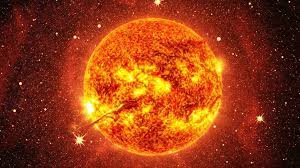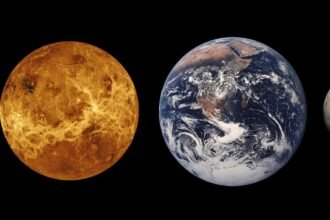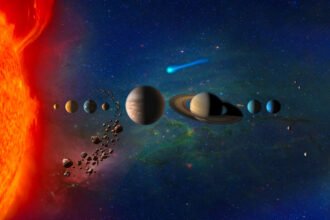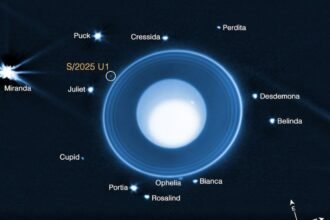The Sun is a G-type main-sequence star (spectral class G2V) positioned at the gravitational center of the Solar System. Composed primarily of hydrogen (~74%) and helium (~24%), it contributes approximately 99.86% of the total mass of the Solar System. Its gravitational field governs the orbital mechanics of planets, dwarf planets, asteroids, and comets. Beyond its gravitational influence, the Sun’s radiative energy output sustains life on Earth, drives climate systems, and shapes the heliosphere — the vast bubble of solar wind extending beyond Pluto.
In this article, we are going to explore the Sun from every angle — tracing its birth from a molecular cloud, the formation of the Solar System, and the layered internal structure that powers it. We’ll examine how it supports life on Earth, the scientific missions that uncover its secrets, and why it remains unreachable by humans. We’ll also look ahead to the Sun’s distant future as a red giant and white dwarf, and reflect on what this means for humanity’s survival and space exploration.
The story of the Sun is not just about a star — it is a gateway to understanding our place in the universe and preparing for what lies ahead.
Formation of the Sun: Stellar Genesis in a Molecular Cloud
The Sun’s story began approximately 4.6 billion years ago in a dense region of a molecular cloud. According to the nebular hypothesis, gravitational instabilities — potentially triggered by nearby supernova shock waves — initiated the collapse of this region. A rotating protostellar core formed at the center, surrounded by a circumstellar accretion disk composed of gas and dust.
This early evolutionary phase laid the groundwork not only for the birth of the Sun but also for the formation of the Solar System. As the protostar’s core temperature rose past 10⁷ K, sustained hydrogen fusion via the proton-proton chain reaction commenced. This ignited hydrostatic equilibrium — balancing gravity and pressure — marking the Sun’s stable entry into the main sequence, where it continues to reside today.
Formation of the Solar System: The Protoplanetary Disk
The processes that formed the Sun were intimately linked with the formation of the Solar System. As the Sun ignited, the surrounding accretion disk — enriched with the leftover material from the Sun’s formation — evolved into the protoplanetary disk. Within this disk, dust particles coagulated into planetesimals and protoplanets through accretion and gravitational interactions.
A temperature gradient within the disk played a crucial role in planetary differentiation: rocky planets formed in the hotter inner region, while gas and ice giants emerged in the colder outer zones. Meanwhile, intense solar wind from the young Sun, particularly during its T-Tauri phase, cleared out residual gas and dust, effectively ending the primary epoch of planet formation. Thus, the birth of the Sun directly sculpted the planetary architecture we observe today.
Solar Internal Structure and Energy Transport
To appreciate how the Sun powers the Solar System, it is essential to examine its internal structure. The Sun consists of several concentric layers, each contributing to its energy production and transport. At the core, nuclear fusion converts hydrogen into helium, releasing ~3.8 × 10²⁶ watts of energy. This energy moves outward through the radiative zone via photon diffusion and then through the convective zone by plasma circulation.
These dynamic layers shape the Sun’s surface and atmosphere. The photosphere, visible to us, exhibits sunspots and limb darkening, while above it, the chromosphere and corona reveal high-energy phenomena. Notably, magnetohydrodynamic processes in the convective zone generate the Sun’s complex magnetic field — the driver of solar cycles and activity.
This internal dynamism is central to the Sun’s interaction with Earth and space, influencing everything from weather patterns to satellite operations.
The Sun’s Role in Earth’s Biosphere
The Sun’s influence reaches far beyond gravitational anchoring or light emission. Its radiation — spanning ultraviolet (UV), visible, and infrared (IR) spectra — fuels biological and climatic systems on Earth. Photosynthetically Active Radiation (PAR) enables primary production in ecosystems, while UV light drives ozone formation and critical atmospheric chemistry.
Infrared radiation regulates Earth’s thermal balance, and the solar wind interacts with our magnetosphere to produce phenomena like auroras. This symbiosis between solar output and terrestrial systems underscores how intimately Earth’s biosphere is linked to the Sun’s behavior and variability.
Understanding these connections enhances our ability to anticipate space weather impacts and underscores why solar observation is vital for planetary sustainability.
Scientific Exploration of the Sun
Our quest to unravel the Sun’s mysteries has driven the development of specialized space missions and observatories. The SOHO satellite monitors solar oscillations and corona dynamics, while the Parker Solar Probe dives into the corona to analyze plasma and magnetic structures up close. The Solar Orbiter provides unprecedented views of the Sun’s poles and probes the solar dynamo.
These missions are not only technological marvels but also critical tools for improving our predictive models of solar activity. Ground-based telescopes, like the Daniel K. Inouye Solar Telescope, complement space missions by providing detailed surface imaging and magnetometry. Together, these instruments deepen our understanding of the Sun and its vast influence across the heliosphere.
Why Humans Cannot Visit the Sun
Despite our technological advancements, sending humans to the Sun remains impossible due to extreme conditions. The corona’s million-degree temperatures, intense radiation, and immense gravity create a hostile environment for life and machinery alike. Even robotic probes like the Parker Solar Probe require advanced heat shielding and carefully planned trajectories to survive near-solar conditions.
These limitations remind us that much of solar science must rely on remote sensing and robotic exploration , highlighting the importance of mission planning and material innovation in future space exploration.
The Sun’s Future: From Red Giant to White Dwarf
Like all stars, the Sun is mortal. It is now about halfway through its ~10-billion-year main sequence life. As hydrogen depletes in the core, it will expand into a red giant, engulfing nearby planets. Brief helium fusion will follow, producing carbon and oxygen, before outer layers are shed as a planetary nebula.
The inert core that remains will form a white dwarf — Earth-sized but extremely dense. Over trillions of years, it will cool into a black dwarf. This transformation reflects universal stellar evolution governed by hydrostatic balance, thermonuclear reaction rates, and energy transport — principles that also shaped the Sun’s early life.
Studying the Sun’s lifecycle gives us a glimpse into the future of our own Solar System and the long-term fate of planetary habitability.
Implications for Humanity and Scientific Planning
The eventual death of the Sun, though billions of years away, has profound implications. Human survival in the distant future may depend on space colonization — starting with Mars or the outer planets. In the nearer term, optimizing solar energy technologies and preparing for space weather threats (such as solar flares and CMEs) are essential.
Strategic investments in heliophysics, planetary protection, and sustainable technologies can ensure humanity thrives even as our star evolves. The Sun’s lifecycle offers a cosmic timeline for human development and scientific foresight.
Conclusion
The Sun is not just a light in the sky — it is a self-sustaining fusion reactor, a source of life and energy, and a window into the workings of the universe. From its turbulent birth in a molecular cloud to its eventual quiet fade as a white dwarf, the Sun exemplifies the processes that govern stars everywhere.
By studying our Sun, we gain insights into plasma physics, magnetohydrodynamics, space weather, and the future of planetary systems. As our closest star, it is both a celestial laboratory and a crucial guardian of life. Continued exploration of the Sun is not only a scientific imperative but a step toward ensuring our long-term survival among the stars.









